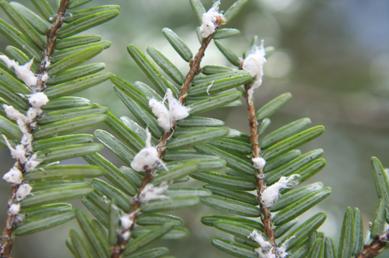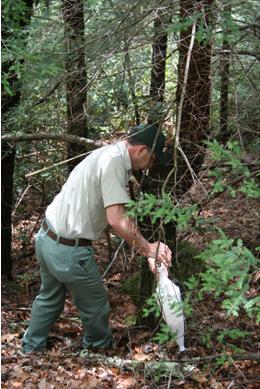Meeting the Threat of the Hemlock Woolly Adelgid
ENTFACT-452: Meeting the Threat of the Hemlock Woolly Adelgid | Download PDF
by Lee Townsend, Extension Entomologist & Lynne Rieske-Kinney, Associate Professor, Forest Entomologist
University of Kentucky College of Agriculture
The hemlock woolly adelgid (HWA), a native of Asia, is a 1/32 inch long reddish purple insect that lives within its own protective coating. White, woolly masses that shelter these sap-feeding insects are at the bases of hemlock needles along infested branches. The presence of these white sacs, which resemble tiny cotton balls, indicate that a tree is infested.
 Hemlock woolly adelgid on hemlock branches
Hemlock woolly adelgid on hemlock branches
HWA is a threat to eastern hemlock forests, and eastern and Carolina hemlock of all sizes are susceptible. Kentucky has a significant hemlock component throughout its eastern forests, all of which could become infested. In addition, ornamental plantings in urban settings are equally susceptible. HWA feeding reduces new shoot growth, and causes grayish-green foliage, premature needle drop, thinned crowns, branch tip dieback, and eventual tree death.
Control Options
Homeowners and private landowners have two treatment options: 1) spray foliage with insecticidal soap or horticultural oil at the proper times during the HWA life cycle, or 2) use a systemic insecticide that moves with the tree sap and is consumed by the adelgids as they feed.
Tree sprays
Several brands of insecticidal soaps and horticultural oils are available at garden centers or from retail stores that sell pesticides. These are contact insecticides that must thoroughly cover the insects to kill them so the foliage, twigs, and branches must be sprayed almost to runoff. Neither product leaves a toxic residue so several applications may be needed. The soaps and oils can be applied to small trees with pump-up garden sprayers but power sprayers are needed to treat larger trees. If coverage is not thorough or trees are too tall for the equipment that is available, surviving HWA soon will reinfest the trees.
These applications will be most effective only during two treatment windows when stages of the HWA that do no have a protective covering are active. One is following egg hatch from March through April, the other is from September to October. Read the product label carefully before purchasing and applying an insecticidal soap or horticultural oil. In some cases, there will be precautions against spraying when temperatures are above or below certain limits, on windy days, or in late spring when the new growth is present on the tree and has not hardened to the dark shade of green.
Insecticidal soaps and horticultural oils can be used in sensitive sites near houses, creeks, or ponds without risk to non-target organisms or the environment. Foliar sprays with other insecticides can be effective but some pose risks to the environment.
Systemic Treatments
Systemic insecticides containing the active ingredient imidacloprid can be used as soil drenches or injections to control the HWA. Brand names include Bayer Tree & Shrub Insect Control Concentrate or Merit Insecticide. Imidacloprid, which is very soluble in water, is taken up by tree roots and moved in the sap to sites where the adelgids are feeding. This approach eliminates the problem of spray coverage, especially on trees that are too tall to treat using available equipment. This treatment should be applied during spring (mid-March to early June) and fall (mid-September to mid-November). The ground should not be frozen or waterlogged but the soil should be moist. Research indicates that the treatment requires at least 30 days to be taken up by the tree, but it can kill adelgids for about 24 months. Homeowners with infested hemlocks may consider soil treatments if HWA has been reported in their county. There is no preemptive treatment for the hemlock adelgid.
There are three methods for applying the systemic insecticide:
1. Soil drenching. The appropriate amount of insecticide, based on the product label, is diluted with water and applied evenly to the soil surface or into a series of small holes spaced evenly around the base of the tree at a distance of 6 to 12 inches. This is followed by an equal volume of water to help move the insecticide down into the soil. Surface litter should be raked away prior to treatment to ensure good penetration. Soil should be moist at the time of treatment so the area may need to be watered in advance if it is dry.
 Treating Hemlock Trees for HWA:
Treating Hemlock Trees for HWA:
Soil Injection
2. Soil injection. The insecticide solution is injected several inches beneath the moistened soil surface with a hand-powered Kioritz soil injector. This injector allows good placement of the insecticide that allows for efficient uptake by the roots, and reduces the chances of runoff of the insecticide from the application site.
3. Trunk injection. Measured doses of imidacloprid are delivered through a small tube that is inserted into holes drilled into the base of the tree. The number of doses required is determined by the circumference of the tree. Trunk injection is not always effective, much more expensive than the soil drench or injection, causes extensive tree wounding that contributes to overall tree stress, and provides a shorter period of protection. However, this approach provides less chance for environmental contamination in rocky soils near open water. Most trunk injections must be made by professional arborists.
Research has shown dramatic recovery of HWA infested trees following applications of imidacloprid in residential settings. In the study, trees with little new growth but no dieback recovered most quickly; trees in poorest condition showed impressive recovery but it occurred more slowly.
Other Practices
Maintain tree health by irrigating trees during prolonged dry periods and remove dead or dying limbs. Adelgid-infested trees should not be fertilized because adelgids thrive on fertilized trees. HWA can be moved from tree to tree by songbirds, so bird feeders should not be placed near hemlocks.
Life Cycle
An understanding of the HWA life cycle is useful because foliar sprays are most effective when the newly hatched "crawler" stage is active. Egg laying begins early, before the first wildflowers bloom in early spring. Small reddish brown nymphs (also called crawlers) that hatch from groups of up to 300 eggs in March either disperse from the tree or settle near the base of needles, sink their sucking mouthparts into twigs, and begin to feed on sap. The crawlers have a distinctive white fringe around their sides, their white protective covering is secreted later. Adelgids without the covering are very susceptible to contact with insecticidal soap or horticultural oil. These adelgids mature over the next few weeks and lay 50 to 200 eggs that will hatch in mid-April to early May. These crawlers are present during the spring flush of hemlock foliage. They settle on new growth and are inactive during the summer. Development resumes in September and partially-grown HWA spend the winter on tree branches and twigs covered by the white woolly material that they secrete. Development resumes in late winter and continues until March when these adelgids mature and begin the two generation per year life cycle again. In one year a single adelgid female could produce 90,000 offspring.
Movement and Dispersal
HWA was first reported in the eastern US in Virginia in the mid 1950's. Since then, it has spread north to Connecticut and south through North Carolina. It reached eastern Tennessee in 2002, and was first reported in eastern Kentucky in spring 2006. The infested area expands at the rate of about 15 miles per year. HWA can be blown by winds, carried by birds and other wildlife, and moved on infested nursery stock. It produces several generations per year and has an extremely high reproductive potential (up to 300 eggs per female) so numbers can increase rapidly in a short time.
Impact on Forests and Landscapes
The HWA is established in about half of the hemlock range in the eastern US and has killed about 90% of the hemlocks in Shenandoah National Park in Virginia. Tree mortality has caused a drastic shift in forest species composition. Because hemlock provides extensive cover and shade and is so prevalent in watersheds and riparian zones, their loss has drastic effects on ecological processes such as nutrient cycling, decomposition, leaching, stream temperatures, and stream organisms. Extensive hemlock mortality leads to a loss of hemlock-dependent wildlife. Song birds are especially at risk. Kentucky has a significant hemlock component throughout the east, all of which is in danger of infestation by HWA. Ornamental plantings in urban settings are equally susceptible.
Biological Control
The HWA came from Asia without any of the natural enemies that keep populations in check in its native range. In addition, it feeds during the cooler parts of the year when our general predators are still dormant for the winter. Several very small lady beetles have been imported and released in an attempt to provide some control of expanding HWA populations.
Outlook
Research on chemical and biological control techniques and resistant hemlock varieties is on-going. Proactive monitoring is essential for early detection of new infestations. Isolated infestations should be treated immediately. Public education and coordinated information dissemination is needed to minimize the impacts of HWA in Kentucky.
Acknowledgments
Rusty Rhea, USDA Forest Service, reviewed this publication and provided valuable input. We thank Dr. Tom Coleman for allowing the use of his pictures.
References
- McClure, M.S., S.M. Salom, and K.S. Shields 2001. Hemlock Woolly Adelgid. FHTET-2001-03.
- Webb, R.E., J.R. Frank, and M.J. Raupp. 2003. Eastern hemlock recovery from hemlock woolly adelgid damage following imidacloprid therapy. J. Abor. 29:298 - 301.
Issued: 5/06
Revised: 5/06
CAUTION! Pesticide recommendations in this publication are registered for use in Kentucky, USA ONLY! The use of some products may not be legal in your state or country. Please check with your local county agent or regulatory official before using any pesticide mentioned in this publication.
Of course, ALWAYS READ AND FOLLOW LABEL DIRECTIONS FOR SAFE USE OF ANY PESTICIDE!
Photos: Tom Coleman, University of Kentucky Entomology
